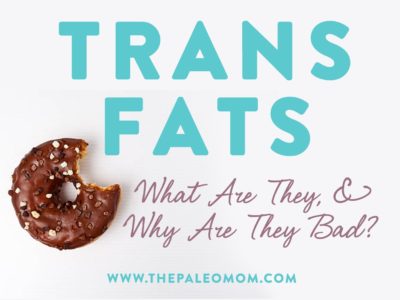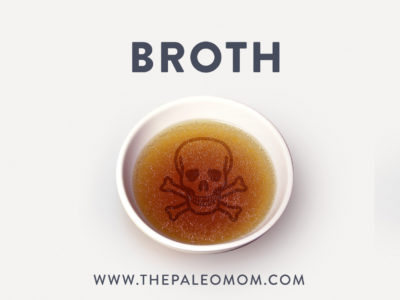One of the benefits of eating Paleo is that it automatically eliminates a harmful component of our modern diets: industrial trans fats. For years, trans fats have been in the news as health hazards, with the potential to increase heart disease risk (by lowering HDL, raising LDL, and increasing inflammation). In 2015, the FDA even enforced a decision to phase out food companies’ use of trans-fat-rich oils altogether. But, even when we know they’re bad, many people don’t understand what exactly trans fats are and how they can harm us! What’s really wrong with this type of fat?
Table of Contents[Hide][Show]
Man-Made Trans Fats
 Commercially, trans fats are formed by taking a polyunsaturated oil (like soybean oil) and injecting it with hydrogen to make it more solid (a process called hydrogenation). This converts some of the cis double bonds to trans double bonds, resulting in partially hydrogenated oils that are high in trans fats. Because of their texture and long shelf life (saturating some of the double bonds makes these fats less susceptible to oxidation), hydrogenated oils were used extensively by food manufacturers to make cheap, shelf-stable products. The highest levels of trans fats are found in margarines, processed snack foods, frozen dinners, commercial baked goods, and fast food.
Commercially, trans fats are formed by taking a polyunsaturated oil (like soybean oil) and injecting it with hydrogen to make it more solid (a process called hydrogenation). This converts some of the cis double bonds to trans double bonds, resulting in partially hydrogenated oils that are high in trans fats. Because of their texture and long shelf life (saturating some of the double bonds makes these fats less susceptible to oxidation), hydrogenated oils were used extensively by food manufacturers to make cheap, shelf-stable products. The highest levels of trans fats are found in margarines, processed snack foods, frozen dinners, commercial baked goods, and fast food.
But, what’s good for the food industry isn’t necessarily good for human health! In numerous studies, trans fats have been linked to higher LDL cholesterol, lower HDL cholesterol, and higher inflammation in a dose-dependent effect (that is, the more trans fat we eat, the more harmful the changes in these risk factors). In mice, trans fats have been shown to reduce the responsiveness of a growth factor called TGF-beta-1 that helps control the growth, proliferation, differentiation, and apoptosis of cells. Population studies consistently link higher consumption of trans fats directly to heart disease. And, some research shows a link between trans fats and diabetes, likely due to the effect on insulin sensitivity and glucose transport when these fats are integrated into cell membranes. Several studies have even suggested that trans fats could raise the risk of certain cancers!
In recent years, the FDA has caught on to this wealth of damning information and have formally ruled that trans fats are not “generally recognized as safe”. The upshot is that within three years of this ruling (June 16th, 2015), all food prepared in the United States must not include trans fats, unless specifically approved by the FDA.
 Naturally-Occurring Trans Fats
Naturally-Occurring Trans Fats
Given the above, the dangers of trans fats might seem like a case-closed issue. But, there are actually other forms of trans fat that occur naturally in meat and dairy, and their health effects are much different than the trans fats in vegetable oils. Unlike the partial hydrogenation process used with industrial oils, ruminants (like cows and sheep) have specific gut microbes that form trans fats through biohydrogenation. The trans fats produced by ruminants have a slightly different chemical structure than industrial trans fats, and as a result, behave differently in the human body. When scientists separate industrial trans fatty acids (iTFA) from ruminant trans fatty acids (rTFA) in studies, ruminant trans fats don’t appear to raise cardiovascular risk factors at normal levels of intake (and even up to over 4% of total energy intake, which is much more than most people ever consume!). One type of ruminant trans fat, vaccenic acid, has been shown to suppress intestinal inflammation and reduce certain endocannabinoids in the liver and visceral fat. And, another ruminant trans fat, the more widely studied conjugated linoleic acid (CLA), can help improve glucose tolerance, facilitate fat loss, protect against certain cancers (by blocking the growth and spread of tumors), and in most studies, has either a neutral or protective effect against heart disease!
In fact, CLA is pretty impressive. Specifically, it
- improves body composition through increased fat metabolism, decreased fat storage, stimulating death of fat cells (adipocyte apoptosis), increased muscle mass and decrease leptin (see page 000).
- blocks the growth and metastatic spread of tumors via effects on arachidonic acid metabolism (impacting prostaglandin, thromboxane and leukotriene formation; see page 000) and modulation of apoptosis (programmed cell death) and cell cycle control.
- prevents atherosclerosis by activating a group of proteins called PPARs that regulate genes involved in lipid metabolism, carbohydrate metabolism, vascular health and inflammation.
- prevents diabetes through improvements in body composition and PPARs’ actions on carbohydrate and lipid metabolism
- improves bone formation by enhances absorption of dietary calcium and by stimulating differentiation (maturation) of bone-forming cells called osteoblasts
- reduce inflammation by reducing expression of pro-inflammatory cytokines like TNF-α and IL-1β while increasing levels of the anti-inflammatory cytokine IL-10
With CLA having so many beneficial effects, you might think to run to the supplement store. Once again, dietary sources win out over capsules—overdoing CLA by loading up on supplements may have some negative effects, such as fatty liver and spleen, colon carcinogenesis and hyperproinsulinemia (where insulin is not sufficiently processed before secretion from the pancreas). Dietary sources of CLA include the fat from grass-fed ruminants and grass-fed dairy. For more on the benefits of CLA, see Conjugated Linoleic Acid (CLA): A Rockstar Nutrient and Goat Milk: The Benefits of A2 Dairy.
The Verdict on Trans Fats
Fortunately, if we stick to a Paleo diet based on whole, nutrient-dense foods, and avoid commercially processed convenience foods and margarine, our intake of industrial trans fats will be zero (or close to it). And, consuming grass-fed ruminant meat and dairy can also supply us with the types of natural trans fats that can actually benefit our health!
Nutrivore Weekly Serving Matrix
An easy-to-use and flexible weekly checklist
to help you maximize nutrient-density.
The Weekly Serving Matrix is very helpful! I’ve been eating along these lines but this really helps me know where to focus vs. which foods serve a more secondary role. It’s super helpful and has taken a lot of worry out of my meal planning. Thanks!
Jan
Citations
Gayet-Boyer C, et al. “Is there a linear relationship between the dose of ruminant trans-fatty acids and cardiovascular risk markers in healthy subjects: results from a systematic review and meta-regression of randomised clinical trials.” Br J Nutr. 2014 Dec 28;112(12):1914-22.
Gebauer SK, et al. “Effects of ruminant trans fatty acids on cardiovascular disease and cancer: a comprehensive review of epidemiological, clinical, and mechanistic studies.” Adv Nutr. 2011 Jul;2(4):332-54.
Jacome-Sosa M, et al. “Vaccenic acid suppresses intestinal inflammation by increasing anandamide and related N-acylethanolamines in the JCR:LA-cp rat.” J Lipid Res. 2016 Apr;57(4):638-49.
Hu FB, et al. “Diet, lifestyle, and the risk of type 2 diabetes mellitus in women.” N Engl J Med. 2001 Sep 13;345(11):790-7.
Ibrahim A, et al. “Dietary trans-fatty acids alter adipocyte plasma membrane fatty acid composition and insulin sensitivity in rats.” Metabolism. 2005 Feb;54(2):240-6.
Lehnen TE, et al. “A review on effects of conjugated linoleic fatty acid (CLA) upon body composition and energetic metabolism.” J Int Soc Sports Nutr. 2015 Sep 17;12:36.
Mosley EE, et al. “Microbial biohydrogenation of oleic acid to trans isomers in vitro.” J Lipid Res. 2002 Feb;43(2):290-6.
Motard-Bélanger A, et al. “Study of the effect of trans fatty acids from ruminants on blood lipids and other risk factors for cardiovascular disease.” Am J Clin Nutr. 2008 Mar;87(3):593-9.
Mozaffarian D, et al. “Health effects of trans-fatty acids: experimental and observational evidence.” Eur J Clin Nutr. 2009 May;63 Suppl 2:S5-21.
Nagao K, et al. “Conjugated linoleic acid enhances plasma adiponectin level and alleviates hyperinsulinemia and hypertension in Zucker diabetic fatty (fa/fa) rats.” Biochem Biophys Res Commun. 2003 Oct 17;310(2):562-6.
Natarajan S, et al. “Dietary trans fatty acids alter diaphragm phospholipid fatty acid composition, triacylglycerol content and glucose transport in rats.” Br J Nutr. 2005 Jun;93(6):829-33.
Ochoca JJ, et al. “Conjugated linoleic acids (CLAs) decrease prostate cancer cell proliferation: different molecular mechanisms for cis-9, trans-11 and trans-10, cis-12 isomers.” Carcinogenesis. 2004 Jul;25(7):1185-91.
Ryder JW, et al. “Isomer-specific antidiabetic properties of conjugated linoleic acid. Improved glucose tolerance, skeletal muscle insulin action, and UCP-2 gene expression.” Diabetes. 2001 May;50(5):1149-57.











